Temple names are commonly used when naming most Chinese, Korean, and Vietnamese monarchs. They should not be confused with era names and posthumous names.
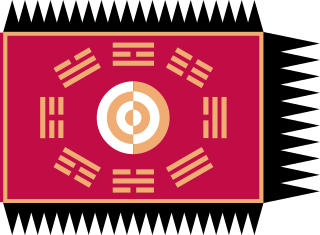
Joseon dynasty was a Korean dynastic kingdom that lasted for approximately five centuries. It was founded by Yi Seong-gye in July 1392 and was replaced by the Korean Empire in October 1897. It was founded following the aftermath of the overthrow of Goryeo in what is today the city of Kaesong. Early on, Korea was retitled and the capital was relocated to modern-day Seoul. The kingdom's northernmost borders were expanded to the natural boundaries at the rivers of Amnok and Tuman through the subjugation of the Jurchens. Joseon was the last dynasty of Korea and its longest-ruling Confucian dynasty.
The Qing invasion of Joseon occurred in the winter of 1636 when the newly established Manchu Qing dynasty invaded Korea's Joseon kingdom, establishing its status as the center of the Imperial Chinese Tributary System and formally severing Joseon's relationship with the Ming dynasty. The invasion was preceded by the Later Jin invasion of Joseon in 1627.
The Veritable Records of the Joseon Dynasty are the annual records of the Joseon Dynasty of Korea, which were kept from 1413 to 1865. The annals, or sillok, comprise 1,893 volumes and are thought to cover the longest continual period of a single dynasty in the world. With the exception of two sillok compiled during the colonial era, the Annals are the 151st national treasure of Korea and listed in UNESCO's Memory of the World registry.
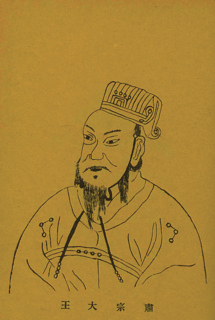
Sukjong of Joseon was the 19th king of the Joseon Dynasty of Korea from 1674 to 1720. A skilled politician, he caused multiple changes of political alliance throughout his reign, switching among the Southerner, Westerner, Soron, and Noron political factions.
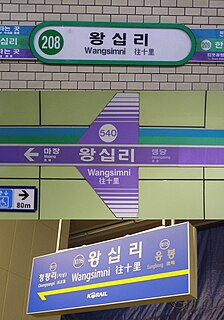
Wangsimni Station is a station on the Seoul Subway Line 2, Seoul Subway Line 5, Gyeongui–Jungang Line, and the Bundang Line. It is located in Haengdang-dong, Seongdong-gu, Seoul.

Jongno District (Jongno-gu) is a gu, or district, in central Seoul, South Korea. It takes its name from a major local street, Jongno, which means "Bell Street".

The National Palace Museum of Korea is a national museum of South Korea located in Gyeongbokgung Palace, Seoul.

A jokduri is a type of Korean traditional coronet worn by women for special occasions such as weddings. It consists of an outer crown which is covered with black silk, and the inner which is filled with cotton and hard paper. Its top is decorated with cloisonné ornaments. The crown is also called jokdu or jokgwan and is used mostly as an accessory. The upper part is vaguely hexagonal and the bottom is cylindrical. The form of jokduri gets narrower from the top to the bottom. jokduri can be used to display the wearer's social status by being adorned with accessories made from gold or silver.

Fujin or bokgeon is a type of guanmao (冠帽), a Chinese men’s traditional headgear made from a black fabric. It was usually worn with Shenyi in the Ming Dynasty and Joseon period of Korea. Though it was initially worn only during important events, it was worn by most men of high-standing by the Joseon period. Members of the scholar-official class decorated their fujin with gold leaf.
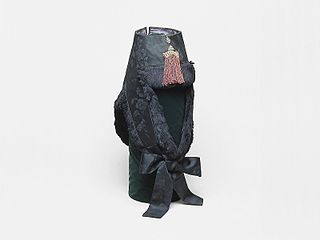
A nambawi is a type of traditional Korean winter hat worn by both men and women during the Joseon period for protection against the cold. The other names for it are pungdengi and nani. The nambawi is also called ieom which was worn in the early Joseon period, although it was derived from the cap. It was originally worn by the upper class as a daily hat, but spread to commoners and women in the later period. It was usually worn by middle-aged women and old people as well as by government officers who put it under the samo.

Daenggi is a traditional Korean ribbon made of cloth to tie and to decorate braided hair. According to the History of Northern Dynasties, maidens of Baekje bound their hair at the back and braided it, while a married women braided her hair into two plaits and secured them to the crown of her head.
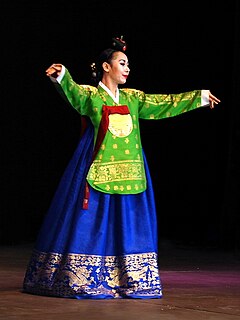
Dang'ui is a type of upper garment for women in hanbok, Korean traditional clothing, which was worn for ceremonial occasions during the Joseon Dynasty. It was worn as a simple official outfit or for small national ceremonies while court ladies wore it as a daily garment. Dangui was also called dang-jeogori (당저고리), dang-jeoksam (당적삼), or dang-hansam (당한삼).
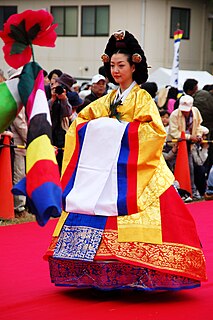
The wonsam is a female ceremonial topcoat in hanbok, Korean traditional clothing. It was worn by queens, high-ranking court ladies, and royalty during the Joseon dynasty of Korea (1392-1910). It is also called 'daeui', 'daesu' and 'jangsam'. The queen, princess consort, and consort to the first son of the crown prince wore it as a soryebok, a robe for small ceremonies, while wives of high officers and sanggung wore it as daeryebok, a robe for major ceremonies.

Geodeulji is a small piece of white cloth to attach to the edge of sleeves of hanbok, traditional Korean attire. Its inner is back up by changhoji (창호지), a type of Korean paper and its width is about 6 ~ 8 cm. Geodeulji is attached to dangui or jangot to cover hands because showing hands in front of seniors was considered not a courtesy during the Korean Joseon Dynasty.

Gyuhap chongseo, roughly translated as "Women's Encyclopedia" is a compendium of advice for women, written by Yi Bingheogak in 1809 during the Korean Joseon Dynasty.
Ruqun (襦裙) is an item of traditional Chinese attire (Hanfu) primarily for women but also for men. It consists of a blouse and a wrap-around skirt. It is the eldest type of hanfu which is said to have been worn by the legendary Yellow Emperor, and it is said to be worn by women since the Warring States period.
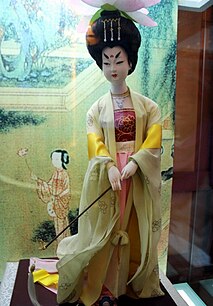
Daxiushan (大袖衫), translated as "Large Sleeve Gown", is a traditional Chinese attire for women and was most popular during the Tang Dynasty amongst the Royals. After the golden age of the Tang Dynasty ended, the influence of Hufu (胡服), or clothing styles from Central and Western Asia, gradually weakened and Tang royal women's clothing styles begin to take its transformation. It was not until the Mid-Late Tang period (中晚唐时期) that the distinctions between Royal women's clothing and other styles became increasingly obvious. The width increased more than four feet and its sleeves are often wider than 1.3 metres. It features distinctive gown that covers the body from the ground to just above the chest with a knot wrapped around the waist, a light and sometimes sheer outer coat that ties together at the bottom and often goes along with a long scarf draped around the arms. The clothing often only covers half of women's breast and so it is restricted to women of a certain status, such as princesses or gējī. It has come to be known as Da-Xiu-Shan but has also been called Dian-Chai-Li-Yi (钿钗礼衣) at various times. The clothing was mainly worn for special ceremonial occasions and have different variations, mainly the result of different collar formations.

Swallow-tailed Hems and Flying Ribbons clothing or Tsa-chü-chʻui-shao-fu is a type of female historical dress which was popular during the Tsʻao Wei, Chin and Northern and Southern dynasties. It is also called Kui-i.

















